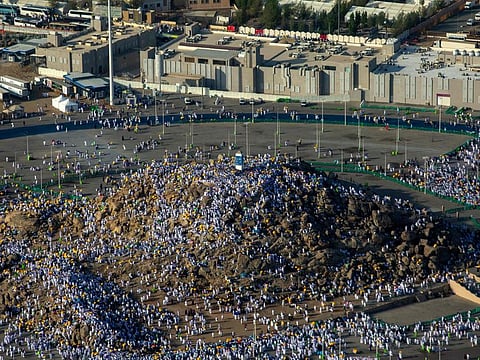Over 83,000 Pakistanis begin Hajj pilgrimage as COVID-19 curbs ease
More than 2,000 Pakistani volunteers are also assisting pilgrims in Saudi Arabia

Islamabad: More than 83,000 Pakistani pilgrims began the spiritual journey of a lifetime as the first rituals of the annual Hajj began in Saudi Arabia.
Pakistan was initially allocated a quota of 81,132 pilgrims for Hajj 2022 but another 2,000 people were allowed by the Saudi authorities later, taking the total number of pilgrims to 83,132.
Chanting “Labbaik Allahumma Labbaik” (O God, here I am answering Your call), the pilgrims gathered around Mount Arafat at the high point of the annual pilgrimage to Mecca. On Friday, the worshippers in plain white clothes and holding umbrellas, recited verses from the Holy Quran as they reached Mount Arafat, also known as the ‘Mount of Mercy’.
“It’s hard to describe what I’m feeling at the moment. I just feel so blessed to be finally here for Hajj with my family to complete my core religious duty,” Sadaf Sharif, a Pakistani citizen, told Gulf News via phone from the tent city of Mina.
Abrar Ahmed Mirza, director-general of Hajj in Makkah, said that Pakistani pilgrims are being ensured the provision of all basic facilities. More than 2,000 Pakistani volunteers are also assisting pilgrims in Saudi Arabia this year. The volunteers are tasked with helping pilgrims access food, transport, and emergency medical aid if required.
Around one million pilgrims, including 850,000 from abroad, amassed in Saudi Arabia’s holy city of Mecca, in the largest Islamic pilgrimage, since the coronavirus pandemic. Last year, only 60,000 pilgrims were allowed for Hajj. All pilgrims selected to perform the Hajj this year are under age 65 and have been fully vaccinated against COVID-19.
Pilgrims spend five days carrying out a set of rituals that date back to the Prophet Muhammad’s “farewell pilgrimage” in 632 AD. After entering Mecca, pilgrims perform the welcome tawaf, circling the Kaaba seven times and then head to the hills of Safa and Marwa.
Pilgrims then set out en masse from Mecca to the vast tented city at Mina where they spend the day. The next day, they head out to Mount Arafat, where the Prophet Muhammad delivered his final sermon. After sunset, pilgrims descend from Mount Arafat and make their way to Muzdalifah to take part in the “stoning” ritual (symbolic stoning of the devil).
On the third day of Hajj, the pilgrims stone the Jamarat Al-Aqabah where the Prophet Ibrahim threw seven pebbles at the devil. After this rite, sacrificial animals are slaughtered on Eid Al-Adha which marks the end of Hajj. Pilgrims then return to Mecca to perform a “farewell” tawaf.
Sign up for the Daily Briefing
Get the latest news and updates straight to your inbox







